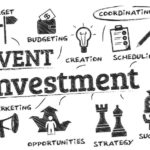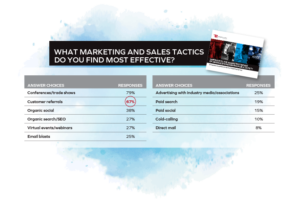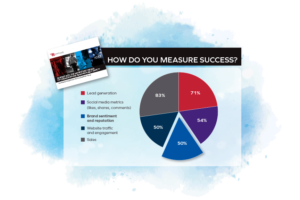There are a few changes brought about from the last two years of the pandemic that are here to stay. One of those is the permanent place for virtual events in public safety. According to a mid-2021 report from ON24, a virtual events platform company, the use of webinars increased 162% in 2020, and attendance nearly quadrupled to more than 60 million people–a total of some 61 million hours of content.
While nothing can take the place of person-to-person connections (a fact that’s doubly true in public safety), the good news is that virtual and hybrid—meaning a mix of remote and in-person—events offer more options to attendees (and marketing teams) than ever before.
If event marketing is part of your overarching strategy, you probably already know that you need to bring more than a great Powerpoint to your approach. So how will you drive interaction and engagement? How can you ensure the people who sign up actually show up (or at least watch your event later)? After all, professionals in law enforcement, 911, EMS, and the fire service are nothing if not busy. So you need to make sure that whatever you create is compelling, authentic and concise.
Here are six specifics about how to engage public safety audiences with your virtual and hybrid events:
DO switch up the format of your webinars and other virtual events. More companies are upending the traditional webinar format to avoid the dreaded Zoom zone-out. After all, there’s no rule that says your event has to last an hour. 30 jam-packed minutes are perfectly respectable (and much easier to fit into the schedules of those in the public sector).
Some webinars start with a brief 10-minute overview or talk and then use the rest of the event to take questions, encouraging the audience to engage with one another (a good moderator is key for this to work). Others use event platforms that allow attendees to answer questions and take polls; the speaker then uses the group’s real-time answers to direct the conversation. Sure, this is more free-form and a whole lot less scripted (and therefore a little scary), but it’s also much likelier to drive audience participation—and stick in your attendees’ memory, in a good way. Still other companies embrace small-group, round-table discussions over, or in addition to, events aimed at larger audiences.
Whatever you do, make sure that those in public safety can access the recording whenever and wherever they have time. After all, public safety leaders and first responders alike have to respond whenever duty calls, and watching your event on their phone or tablet in the rig or patrol car should be as easy to do as if they were at their desk.
DO your homework about the public safety vertical you want to connect with. What’s on the minds of the customers or prospects you’re trying to reach? What problems are they struggling with every day that your product or service will solve? Difficulty in staffing, recruitment and retention and first responder mental health are huge issues currently.
A December 2021 report from Motorola on 2022 trends in public safety found that citizens believe technology can and should transform public safety and that COVID-19 has accelerated that change. The report included a number of case studies showing how technological transformation is happening across the globe—all content that’s great to explore in a virtual event, especially when prospects can hear from current customers who’ve benefited from working with you.
DO use virtual events as a way to gather insights and information about your customers and prospects. Offering something of real value to your attendees is the single best way to drive registration. But there’s no reason why learning can’t go both ways. So just as you engage in social listening on whatever social media platforms you use, these virtual and hybrid events are chances to invite a conversation that can deepen your understanding of your customers and what they need right now. (P.S. There may be other ways to apply your newfound expertise. A January 2022 Vimeo survey found that 52% of respondents also use virtual events for employee training or onboarding, for instance.)
Professionals in public safety thrive on sharing lessons learned. Virtual events are a good way to get them talking about use cases and what they found that worked and didn’t work. Also be sure to use the registration process itself to glean important information about potential leads (our bonus content will help you with that.)
DO build excitement about your event before the big day. According to the same ON24 report, 39% of registrants sign up for a webinar eight or more days in advance, while 20% register at least 15 days prior to the event. That’s an opportunity: Drive those registrants to a compelling landing page where you share new content, invite them to network with fellow attendees, vote on conference topics or tracks, pose questions to speakers, or enter a raffle.
If the event is a conference, make it easy to see the full program agenda and speakers (we too often see this information missing or incomplete on the event’s website.) Also, make it easy for public safety leaders to share the information with their peers who might want to attend. (Peer-to-peer recommendations go a long way). Remember that in public safety, the work they do is nearly always done by a team, not individuals, so make it easy for people to register their peers, too.
And while this may seem painfully obvious, check every step of the registration process to make sure it’s as fast and intuitive as possible (another all-too-common mistake).
DO embrace the asynchronous nature of virtual events. According to one statistic, just 40% of webinar attendees pay attention to the entire event. Which means more than half drop off at some point before you wrap things up. And those are the ones who actually show up after registering. In public safety, we see that typically about half show up for a live virtual event, and the other half will tune in later at a time that’s convenient for them.
So-called “self-service” content should be part of your content marketing strategy. This simply means that customers want to consume information when and where they want to. So make it easy for them to find you, learn more about what you do and see testimonials and case studies from others in their field, especially when you’re building awareness about your brand and trust.
Another change wrought by COVID: Digitally-enabled sales interactions are now far more important. A McKinsey report on B2B sales states that “buyers cited a strong preference for self-service…channels across every stage of the customer decision journey.”
DO follow up your virtual event with supporting content. Your virtual event is just one (and maybe your first and only) chance to engage a prospect with compelling information. Use the days and weeks immediately after to make it easy for those who signed up to watch, rewatch and share the event and to explore supporting content—an Ebook, white paper, guide, a survey or invitation to your next webinar or in-person event.
Larger purchases for the public sector typically require a lengthy and often complex procurement and purchasing process involving multiple decision makers, so definitely make sure it’s easy for your attendees to share the webinar and supporting content with any and all stakeholders.
Even smaller pieces of content can keep people interested as they learn more about what you do and decide whether your product is the right fit. If, say, you sell a complex call-handling technology suite for PSAPs, your prospects may prefer a steady (not too frequent!) stream of easy-to-consume content like blog posts or brief videos explaining how your solution will integrate with their existing software, help you manage your resources or save money on staffing.
If you’d like to talk about improving your virtual or in-person event marketing strategy for public safety,we’d love to hear from you.
Related Posts
-
You’re at a national conference where you normally exhibit (remember those days?). But this year…
-
The public safety market isn’t all that big. Spotting the organizations that find marketing success…
-
It’s a common lament among companies and organizations serving healthcare and public safety: there are…










 The RedFlash Group is a GSA Contract Holder under Schedule 541, Advertising and Integrated Marketing Solutions
The RedFlash Group is a GSA Contract Holder under Schedule 541, Advertising and Integrated Marketing Solutions